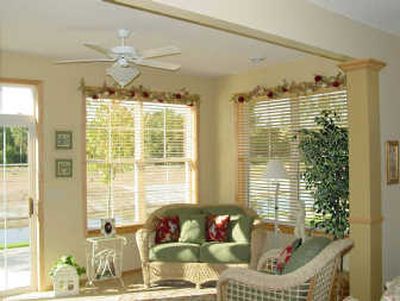Home’s locale plays role in use of energy

Question: I have read a lot about ideas for positioning a home on a lot to take advantage of the sun’s light and warmth, but I’m not sure exactly what this strategy entails. Can you explain it?
Answer: I can. You’re absolutely correct that the proper positioning of a home can have a huge impact on energy bills and indoor comfort. Windows expert Ross McCluney of the Florida Solar Energy Center has done a lot of research in this area and he notes that the basic answer lies in what advantage you want from the sun. For example, if you’re building a home in a northern climate and your priority is to take advantage of solar heat gain in the winter, you need to have a lot of window glazing facing the sun in the afternoon. Locate the home so that a side faces toward the west or southwest.
But if you’re more interested in enjoying the sun’s warmth in the morning, then orient it more to the southeast.
Keep in mind that too much unprotected glazing facing the direct sun can cause overheating and glare when the sun shines strongly, so you want to be sure to use outside shades or indoor drapes or blinds to control the sun.
McCluney notes that large panes of glass on the south wall will be very effective in bringing in solar heat gain during much of the middle of the day. By having good-size overhangs over these windows, you will reduce the unwanted heat gain in the summer when the sun is higher in the sky.
If you want to be more precise in figuring the sun’s exact position in the sky at various times of the year, check some search engines on the Web for sun angle charts or sunpath diagrams. You can also get some good information on window orientation at www.fsec.ucf.edu/en/ consumer/buildings/homes /windows/shading.htm .
Q: We’ve had a lot of company this summer and our utility bills have been considerably higher than usual. In trying to figure this out, one thing we have noted is that we’re doing quite a bit more laundry than usual. Seems like almost every afternoon we’re using the washer and dryer. Could this be having much of an effect?
A: It’s probably a major cause of your higher bills this year.
Think about that clothes dryer for a minute. It’s got a powerful fan that pushes air past wet clothes at a pretty fast clip — enough that in a typical home, a dryer can empty a full house-load of air every hour. During the summer, your dryer has been taking air from indoors (air that you used your air conditioner to cool) and blew it outside through the dryer vent. As that indoor air was pushed outside, you probably had a lot of hot air from outside leaking in through cracks and leaks and poorly sealed windows and doors and lots of other places, so now the air conditioner has to work harder to cool off that air that has been pulled inside.
I don’t suggest that you let your company run around in dirty clothes, but you might consider doing the laundry at night or at cooler times when you won’t be losing conditioned air that will be replaced by warmer outdoor air leaking inside. This is why many energy experts advise putting laundry rooms either in the garage or in an uncooled utility room if possible.